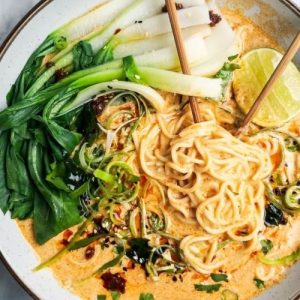These quick spicy coconut noodles are the perfect balance of comfort and nourishment, ready in just 20 minutes.
A creamy coconut broth infused with gochujang, garlic, and ginger delivers bold flavor, while fresh pak choi and herbs add a boost of fiber and vitamins.
With plant-based protein, healthy fats from coconut milk, and low saturated fat, this simple one-pot dish is both satisfying and wholesome—ideal for weeknights or easy meal prep.

20-Minute Vegetarian Coconut Noodles
Equipment
- 1 large saucepan or pot
- 1 Wooden spoon or spatula
- 1 sharp knife
- 1 cutting board
- 1 citrus squeezer (optional, for lime)
- 4 serving bowls
Ingredients
- 2 tablespoons gochujang paste
- 1 tablespoon soy sauce
- 2 teaspoons fish sauce or vegan alternative/more soy sauce
- 2 tablespoons chili oil plus extra for serving
- 2 garlic cloves crushed
- 1 tablespoon fresh ginger grated (or 2 teaspoons ginger paste)
- 1 lemongrass stalk lightly crushed and cut into 3 pieces (or 1 tablespoon lemongrass paste)
- 400 ml 14 oz can coconut milk (choose one with >60% coconut extract)
- 1.2 liters 5 cups vegetable or chicken stock
- 200 g 7 oz noodles of choice
- 2 heads pak choi sliced
- 4 scallions spring onions, finely sliced
- Small handful fresh cilantro coriander leaves
- 1 lime cut into wedges
Instructions
- Build the Flavor Base: Place a large saucepan or deep pot on the stove and set it over medium heat. Add the gochujang paste, soy sauce, fish sauce (or vegan substitute), and chili oil. Stir these ingredients together for about 1–2 minutes, letting them warm through and release their rich, spicy aroma. Next, add the crushed garlic and grated ginger. Stir continuously so they don’t burn—this gentle cooking will unlock their natural fragrance and give the dish its signature depth of flavor.
- Prepare the Coconut Broth: Once the aromatics smell fragrant, pour in the coconut milk along with the pieces of lemongrass. Follow this with the vegetable or chicken stock. Stir thoroughly to blend the chili base with the creamy coconut milk, creating a smooth, vibrant broth. Allow the mixture to come up to a gentle simmer, then reduce the heat slightly and let it bubble quietly for about 5 minutes. This resting simmer allows the lemongrass and spices to infuse the broth with brightness and complexity.
- Cook the Noodles in the Broth: After the broth has developed its flavor, add the noodles directly into the pot. Stir well so they don’t clump together, and check the packet instructions for the recommended cooking time. Most noodles will need about 4 minutes, but times vary depending on type and thickness. As the noodles cook, they will absorb the spicy coconut broth, becoming silky and flavorful. Stir occasionally to ensure even cooking and to prevent sticking at the bottom of the pan.
- Add Fresh Vegetables for Balance: When the noodles are nearly done, add the sliced pak choi into the simmering broth. Gently stir to coat the greens in the hot liquid. Within just a minute, the pak choi will turn bright green and tender while still retaining a slight crunch—this keeps the dish both fresh and nutritious. Immediately remove the pot from the heat to avoid overcooking the vegetables, which could cause them to lose their vibrant color and crisp texture.
- Assemble the Noodle Bowls: Divide the noodles and pak choi evenly into four serving bowls. Ladle plenty of the coconut broth over each portion, making sure every bowl gets a generous amount of sauce. The noodles should be saucy rather than soupy—creamy enough to cling to the noodles, yet brothy enough to sip.
- Add Garnishes and Final Touches: Finish each bowl with freshly sliced scallions and sprigs of cilantro for a burst of color and freshness. Squeeze a wedge of lime over the top to cut through the richness of the coconut milk with a refreshing citrus zing. For extra heat and flavor, drizzle a little more chili oil across the surface. Serve immediately with additional lime wedges on the side, so everyone can adjust the acidity to their liking.
Notes
- Customize Your Protein: This recipe is very versatile. For a plant-based version, stick to tofu or edamame. If you prefer animal protein, cooked chicken, shrimp, or even thinly sliced beef can be added directly to the simmering broth with the noodles.
- Vegetable Variations: While pak choi is traditional, feel free to swap or add other greens like spinach, bok choy, snow peas, or green beans. Add denser vegetables earlier in the cooking process to ensure they soften properly.
- Noodle Choices: Any noodles work here—ramen, rice noodles, udon, or whole-grain spaghetti. Adjust cooking time according to the type, as thicker noodles will need longer to soften.
- Adjusting Heat Levels: Gochujang paste is spicy, but you can tailor the heat by adding less chili oil or substituting with a milder chili paste or sriracha.
- Coconut Milk Tips: Use full-fat or at least 60% extract coconut milk for a creamy texture. Shake the can before opening to mix the solids and liquid for even consistency.
Chef’s Secrets for Perfect Noodles
Creating the ideal spicy coconut noodle bowl is all about layering flavors.
Start by toasting your aromatics—garlic, ginger, and chili paste—in oil to release their natural oils and fragrance.
Don’t rush the coconut broth; letting it simmer briefly with lemongrass intensifies the aromatic profile.
For noodles, cook them directly in the broth rather than separately.
This technique allows the starches to thicken the sauce slightly and ensures every strand absorbs flavor.
Lastly, always finish with fresh herbs and a squeeze of lime to brighten the dish and balance the richness of the coconut milk.
Serving Suggestions for Maximum Flavor
Serve these spicy coconut noodles in generous bowls, making sure each portion includes both noodles and vegetables with plenty of broth.
Garnish with fresh cilantro, scallions, and a drizzle of chili oil for an extra kick.
Pair the dish with light sides like pickled vegetables, cucumber salad, or steamed dumplings to complement the creaminess.
For an authentic touch, offer lime wedges on the side so each diner can adjust acidity to their preference.
This dish works beautifully as a standalone meal or as part of a larger Asian-inspired dinner spread.
Storage Tips to Keep Fresh
These noodles can be stored in an airtight container in the refrigerator for up to 3 days.
Keep in mind that the noodles will continue absorbing the broth as they sit, which can thicken the mixture.
When reheating, add a splash of water or stock and heat gently on the stove to loosen the noodles and restore the sauce’s creamy consistency.
Avoid reheating in the microwave at full power for long periods, as this can overcook the vegetables and change the texture of the noodles.
Frequently Asked Questions
1. Can I make this recipe vegan?
Absolutely! Replace the fish sauce with a vegetarian version or simply use extra soy sauce.
Ensure your chili paste is vegan-friendly, and the dish remains equally flavorful and satisfying.
2. What types of noodles work best?
Most noodles work well, including ramen, udon, rice noodles, or even spaghetti.
The key is to cook them directly in the broth and adjust cooking times according to the type and thickness of the noodles.
3. How spicy is this recipe?
This recipe has a medium heat level by default. You can control the spiciness by adjusting the gochujang paste and chili oil amounts.
For a milder version, use less chili oil or a milder paste.
4. Can I prepare this in advance?
Yes, you can make the broth ahead of time and store it separately.
Cook the noodles and vegetables fresh when ready to serve to maintain their texture.
This method works well for meal prep.
5. What other vegetables can I add?
Feel free to add greens like spinach, bok choy, green beans, or peas.
Denser vegetables, like carrots or bell peppers, should be added earlier to cook through.
The recipe is very adaptable, so mix and match based on what’s available.

